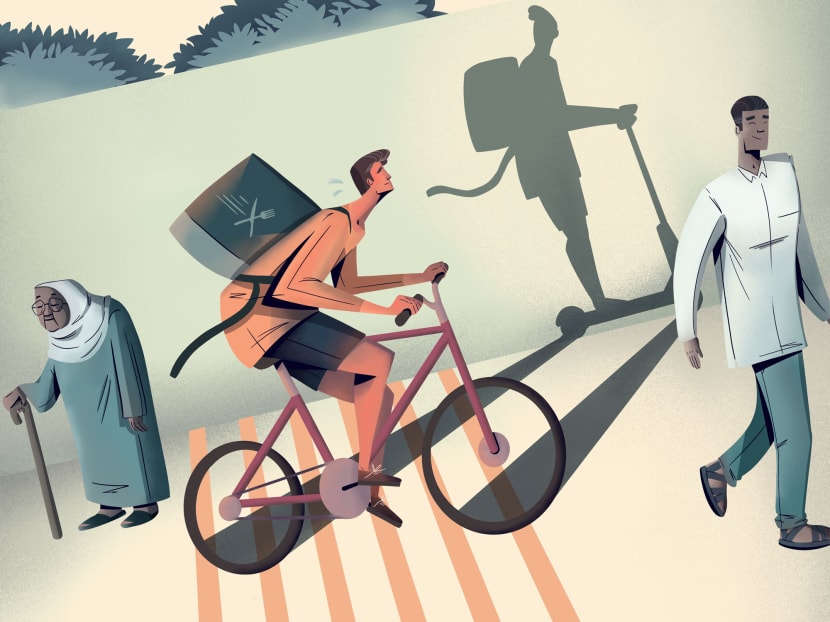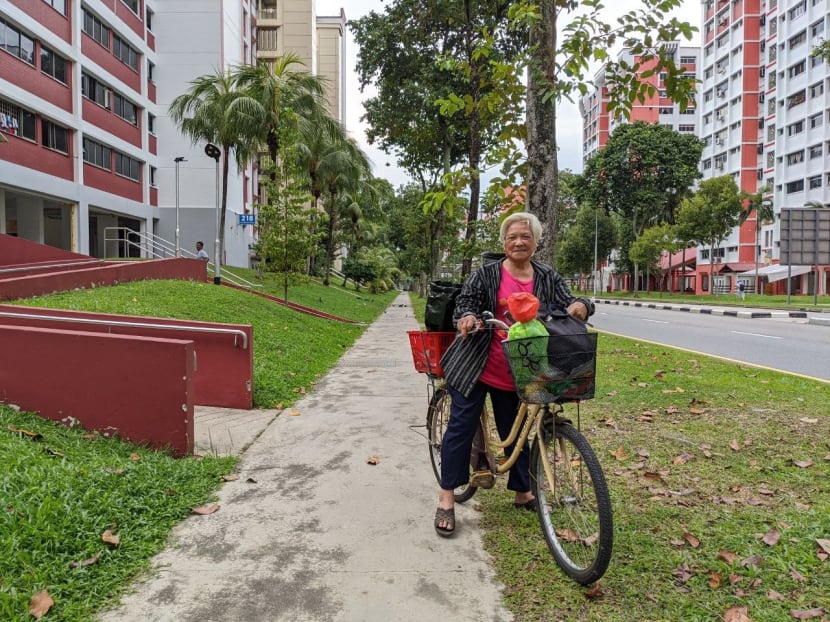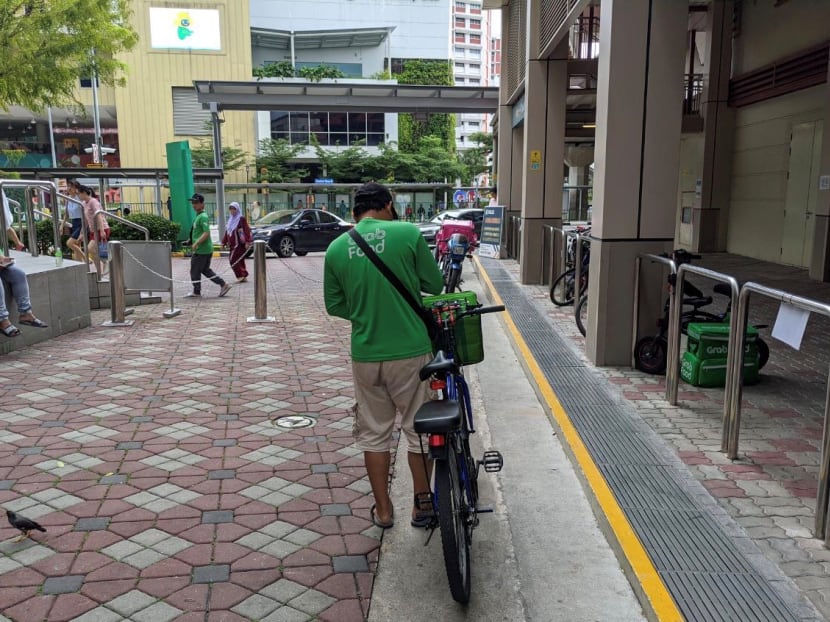The Big Read: After the sound and fury, the dust settles on e-scooter footpath ban
SINGAPORE — Like a bolt from the blue, the Nov 4 announcement by the Government that electric scooters would be banned from footpaths the very next day caught many people off guard. A ban on other personal mobility devices (PMDs) will be rolled out progressively by the first quarter of next year.

Many pedestrians gave the thumbs up for the ban while e-scooter users were wringing their hands over the loss of a convenient and cheap means of transport — and a potential big drop in earnings for food delivery riders.
SINGAPORE — Like a bolt from the blue, the Nov 4 announcement by the Government that electric scooters would be banned from footpaths the very next day caught many people off guard. A ban on other personal mobility devices (PMDs) will be rolled out progressively by the first quarter of next year.
The ban came amid a rise in errant behaviour and incidents involving e-scooters or other PMDs. Between Jan 1 and Sept 30, there had been three fatalities.
Many pedestrians gave the thumbs up for the ban while e-scooter users were wringing their hands over the loss of a convenient and cheap means of transport — and a potential big drop in earnings for food delivery riders.
In the immediate aftermath, scores of food delivery riders turned up at the meet-the-people and dialogue sessions held by Members of Parliament to vent their frustrations and unhappiness.
To allay their anxiety, the Government, along with three major food delivery firms, announced a S$7 million e-scooter trade-in grant to help food delivery riders switch to other vehicles.
For PMD retailers, the impact has been swift and heavy: Sales of e-scooters have plunged to zero for some of them in recent weeks, as they mull over ways to get rid of their stockpiles.
For others such as pedestrians, food delivery riders and people who use PMDs for daily commute, they are still adjusting to life after the ban.
By and large, pedestrians interviewed, some of whom had their own stories to tell of close shaves with speeding riders, were glad: They no longer need to approach footpaths with trepidation, or look over their shoulders nervously — sometimes with young kids in tow — while walking on pavements.
Nevertheless, they could still see some errant riders zipping around illegally on footpaths, and they could not wait for the start of next year when the Land Transport Authority (LTA) takes a “zero-tolerance” approach.
There is an “advisory period” currently in place until the end of the year, where warnings would be given out to offenders but the LTA reserves the right to enforce the rules for more serious cases.

Meanwhile, in spite of their misgivings about the ban, some food delivery riders have started to switch to alternate modes of transport, be it bicycles or electric bicycles. The adjustment has come with its own set of challenges, they told TODAY, such as fewer deliveries in a day, fitness issues and safety concerns.
Those who have stuck to their e-scooters have found themselves taking a longer time to fulfil orders should they choose to stick to park connecters and bicycle paths. Some are nevertheless taking their chances by playing a cat-and-mouse game with the authorities — using footpaths in the evenings to make deliveries in the hope that they would not be caught.
Those caught riding an e-scooter on footpaths risk being fined up to S$2,000 and/or jailed up to three months, and the LTA carries out enforcement action regularly including during the evenings.
Given the inevitable clampdown, the food delivery riders are under no illusion that they can continue to skirt the ban come the new year, and some have decided to search for new jobs.
For those who had depended on e-scooters for their daily commutes, the impact has been less drastic compared with food delivery riders. Nevertheless, it has resulted in longer travel times to their workplaces and increased travel costs.
PEDESTRIANS FEEL SAFER NOW
These days, 58-year-old Loy Chit See no longer feels bothered or stressed when he takes his children out for walks at the weekend. The same could not be said before the ban, when e-scooters could be seen everywhere in his Serangoon estate.
“I nearly got knocked down once, the guy just sped past and I couldn't believe it,” said the father of two children aged seven and ten. “The stress becomes high … When I walk (my children) to NEX (shopping mall), I have to be extra careful.”
After the ban, Mr Loy said the number of e-scooters he sees in his neighbourhood has dropped significantly.
Like Mr Loy, many of the 16 pedestrians whom TODAY spoke to across e-scooter “hotspots” such as Punggol, Choa Chu Kang, Yishun and Serangoon, welcome the ban.

Punggol resident Ng Cheow Yong, 76, said e-scooters in his estate typically move at frightening speeds. As he walks while running errands, he worries that given his advanced age, he will be unable to react when an e-scooter approaches from behind.
Mr Ng said that he is less stressed now that there are fewer e-scooters. He sees about one or two on his walks, unlike before when about five or six riders would speed past him.
When asked if he thought food delivery riders were having it tough, Mr Ng disagreed. “It’s fair that these food delivery riders have to find alternative arrangements, as long as the pedestrians are kept safe. If they were to continue riding, then where should we walk?”
A Punggol resident, who wanted to be known only as Mrs Tay, agreed that the ban had resulted in fewer e-scooters plying her estate, but said her family would only feel safe six months down the road, when the full impact of the ban could be felt.
The 32-year-old said she still sees some e-scooter riders flouting the law by riding on footpaths.
Mrs Tay, who has a three-year-old daughter and a newborn son, added: “We see that our neighbours all have kids, and they’re all playing in the playground, learning to walk or are crawling. And then there are PMDs zooming all around through the playground … it’s quite stressful and scary. We want to co-exist, but it’s quite difficult.”
Still, some felt that a ban was too drastic a step and pedestrians have a part to play too.

Punggol resident Carene Law, who has three children aged 3 to 9 years old, saw it as her own responsibility to keep her kids safe.
“It is my responsibility to take care of my kids. I will ask my kids to just look around, when you see anything just keep to one side,” Ms Law said.
Agreeing that parents should keep a close watch on their children, Yishun resident Marina Rahim, a mother of two, said that she frequently sees pedestrians with their eyes trained on their phones, totally unaware of their surroundings.
“We, as pedestrians walking, have to be alert. Sometimes the PMDs, they speed, but sometimes they will also alert us with a signal and all… both parties should share the blame (should an accident occur).”
Retiree Tham Ah Ngjoon, 78, who frequently rides her bicycle around Choa Chu Kang while on errands, said that she keeps a lookout for the e-scooters that traverse her area, but is not afraid of them.
“When they come riding towards me from afar, I make sure to stick to one side of the pavement, and they will signal and slow down as well most of the time,” the Choa Chu Kang resident of over 30 years said in Mandarin.
“Some are reckless, especially the younger riders. But most are mindful.”
FOOD DELIVERY RIDERS: EARNINGS FALL BUT SOME FIND A WAY
As early as February, 34-year-old Muhammad Imran had seen the writing on the wall. At that time, there had been an increase in accidents involving PMDs on footpaths, and calls of a ban were growing louder.
The part-time food delivery rider thus decided to switch to riding a bicycle. But for Mr Imran, who was obese at that time and weighed 120kg, it was difficult to adjust initially.
“When I first started, I would only do two orders, and then I would be extremely (tired)... I was not fit at all.” Back then, he would only earn about S$10 a day before throwing in the towel.
Things only started to improve after he had cycled for four to five months. Today, Mr Imran is able to deliver 25 orders a day on his bicycle, and is earning as much as when he was riding his e-scooter — about S$130 a day. He has also gotten fitter, having lost more than 30kg.
He reckoned that it would take an average e-scooter rider about three months to get used to the new mode of transport.
“Riders should give themselves some time, and think of it as a way to increase your fitness and also to help you to be (healthier compared) to those who are just riding around on e-scooters.”
However, among the 11 food delivery riders whom TODAY spoke to, most bemoaned the lack of time to adjust to the new situation due to the suddenness of the ban.
With the ban, e-scooters are now confined to bicycle tracks, paths shared by pedestrians and cyclists, and park connectors. Electric bicycles, however, may be used on roads, while bicycles are allowed on footpaths and roads.
Riders who had switched to riding bicycles generally said their earnings had dropped by about half.

Part-time delivery rider Cindy Goh, who is in her 30s, said most of her deliveries require her to ride for about 2 to 3km. Once, she had to cycle for more than 4km.
“I rode until I was half-dead,” she said of her longest ride to date. “Not that I was riding very slowly, but whenever there was a steep slope, I had to dismount my bicycle and push.”
Ms Goh, who does deliveries around Jurong Point shopping mall, said she often had to cancel orders from the Nanyang Technological University, due to its distant proximity and high slopes on the campus grounds. She used to be able to deliver to those areas on her e-scooter.
While Ms Goh used to deliver more than 10 orders a day on her e-scooter and earned about S$50, she can only do half the amount on her bicycle, and earns about S$25.
For riders who have stuck to using their e-scooters, their earnings have also taken a hit.
Ms Sarah Alatas, 22, said she now makes it a point to take longer routes that have park connectors or bicycle paths. She would dismount and push her e-scooter on footpaths. If the delivery route comprises primarily of footpaths, she would decline the order.
Due to these difficulties, she has seen a drop in her earnings. While she used to earn S$150 a day from deliveries, the amount has fallen to S$50. She has since taken up an extra job as a security guard at night to supplement her income, and works 14-hour days to make ends meet.
She said: “When they banned (e-scooters on footpaths), it changed my entire career path. I was looking to do food delivery full-time, but now I have no choice but to (juggle two jobs).”
A full-time food delivery rider who only wanted to be known as Ms Ikah said she has stopped using her e-scooter to do deliveries in the day. However, she continues to flout the ban at night in the hope that there is less chance of her getting caught.
“I normally start (making deliveries) after 7pm, and work until the last order at 2am,” said the 29-year-old, who is a single mother supporting three young children.
By doing this, her working hours have shortened and while she used to earn S$70 a day, she is now making half the amount.
She acknowledges that the current situation is untenable. Come January, she will be looking for a new job. “A part-time job, any day job will do,” she said.
Asked why she did not consider applying for the trade-in grant, she cited safety concerns about riding an e-bike on the roads.
Many riders interviewed by TODAY said they have applied for the trade-in grant, and are waiting to confirm their e-bike orders.
Mr Jim Hon, a full-time food delivery rider, had spent the past week riding an e-bike which he had already owned before the ban. For the first few days, Mr Hon rode his e-bike on some footpaths due to safety concerns, even though this was against the law.
“The cars and motorbikes are moving much faster than me, and unless I can travel as fast as them, I will not feel safe on the roads,” he said. “I can be very experienced, but if someone on the road makes a mistake, any brush (by another vehicle) could be fatal.”
The 37-year-old, who previously delivered food on an e-scooter, said that riding an e-bike comes with its own challenges.
“You need to think about the direction of the traffic,” he said. “You need to turn one big round (to follow the flow of traffic), even though you know that just across the street is your location to send your order. Unless you’re as fast as a motorbike, you will incur a delay.”
HOW OTHER E-SCOOTER USERS ARE ADAPTING
For Mr Mohammad Subhan, the ride from his Pasir Ris home to his workplace at Marina South Pier used to take one hour with an e-scooter. His route to work — which he estimates to consist of footpaths for about a third of the journey, with the rest being either park connectors or bicycle paths — has taken half an hour longer since the ban.
The part-time operations manager of a boat charter service now either slows down when he rides on footpaths, or dismounts his e-scooter to push it.
The 47-year-old does not mind the hassle since he could save a few dollars on public transport daily.
“To me (this is time for) a slow ride, to relax, to get out of the house early... If I take a feeder bus, and then the MRT, it will be S$4 gone,” he said.
For Mr Mohammad Fadil, a technical officer at SMRT’s Kim Chuan Depot, his commute from his Bedok Reservoir home to his workplace at Tai Seng takes him about 45 minutes by bus. This is 15 minutes slower than when he travels by e-scooter.
Following the ban, the 37-year-old now skips his usual breakfast and lunch haunts, which he would stop by previously on his way to work riding his e-scooter. In the past few weeks, he has been having his meals at his workplace canteen instead.
In his spare time, Mr Fadil does charity work with a group called B2K Crew, which he had formed with his friends. They used to ride e-scooters together and help clean up flats occupied by the elderly or lower income families in various Housing and Development Board estates.
The e-scooters were convenient for getting cleaning supplies on the go and for the group members to quickly get to different locations. Now, they no longer use these devices as much as before.
“We have two more charity events to go to, and I don’t know if we are going to scoot there, or (use a ride-sharing service) to get there,” said Mr Fadil.
For those working in less accessible locations, e-scooters used to be a convenient way to avoid the squeeze in feeder buses.
Mr Mahadi Md Johari, a housekeeper at a nursing home, previously rode his e-scooter from his circuit road home to his workplace at Serangoon Gardens.
Now, he takes a bus from his home, before switching to a feeder bus. A trip that used to take about 25 minutes by e-scooter now takes almost twice as long. He also has to fork out S$3.50 a day in transport fares to get to work.
“I have no choice, maybe I will try to get an e-bike, but it’s still not as convenient as an e-scooter, because you need to ride on the road,” he said.
Mr Mahadi lamented that the actions of some black sheep have caused the authorities to enact a ban — to the chagrin of responsible users. “Now everyone has to pay for it,” he said.








